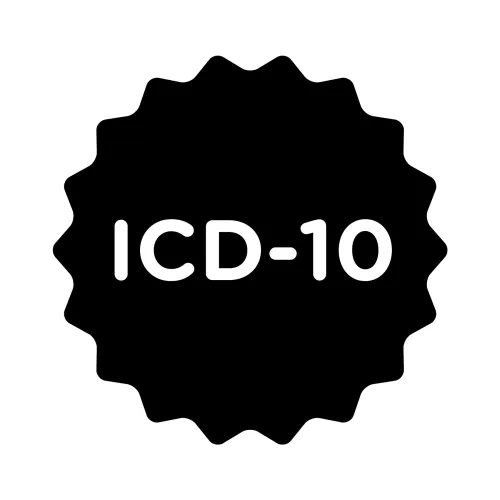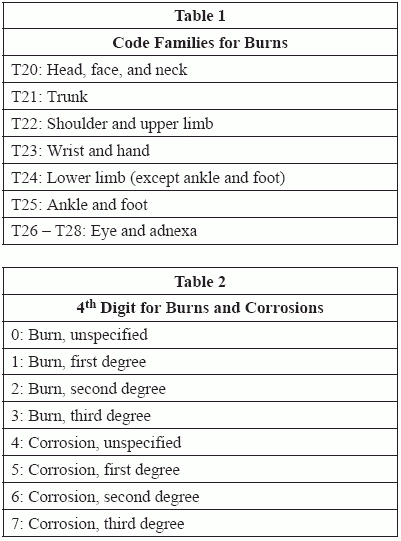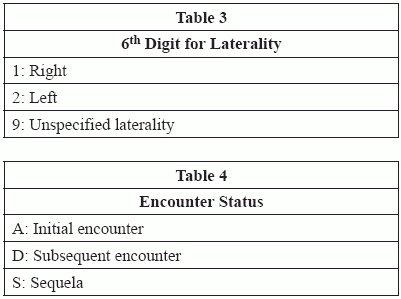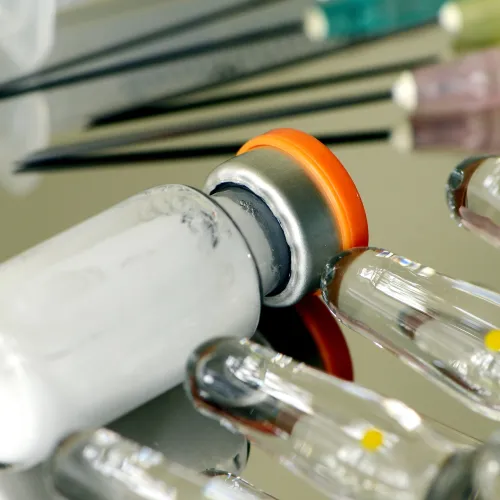Outpatient Facility Coding Alert
Heal Your Burn Woes with a Comprehensive Understanding of the Codes

Each of the seven characters defines the indication.
Just as in ICD-9-CM, coding a burn in ICD-10 requires information about the body site, depth, extent, and cause of the burn. However, ICD-10 also requires information about the laterality of the burn and whether the encounter is initial, subsequent, or for sequela of the burn injury. Read on for your refresher on how each of the alphanumeric characters communicates specific information about the injury and the encounter with the physician.
Start by Mapping Each Character
The easiest way to understand how burn diagnosis codes are structured is to break them down by character. Use the following tables to help you see how the pieces fit together.

Note that ICD-10 makes a distinction between burns and corrosions. Burn codes apply to thermal burns (except sunburns) that come from a heat source, such as fire, hot appliance, electricity, and radiation. Corrosions are burns due to chemicals.

Watch other parameters: In addition to the distinction between burn and corrosion, there are other attributes to pay attention to when coding for burns. These include:
-
Sequencing: When more than one burn/corrosion is present, sequence the code that reflects the highest degree first.
-
Burn/corrosion from the same local site: Classify burns of the same local site, but of different degrees, to the subcategory identifying the highest degree recorded in the diagnosis.
-
Non-healing and infected burns/corrosions: Non-healing and necrosis (death) of burned skin should be coded as acute burns. For any infected burn site, use an additional code for the infection.
Check the ICD-10 Coding in a Step-by-Step Scenario
Practice choosing the correct characters with this example: Your patient has a second-degree burn of the left foot from hot bath water.
Step 1: Code the location and degree of the burn, plus the encounter level. For this patient, the burn is second-degree on the left foot. That leads you to category T25 (ankle and foot), then additional characters 2 (second degree burn), 2(foot), 2 (left side), and A (initial encounter). The final code is T25.222A (Burn of second degree of left foot, initial encounter).
Remember: In ICD-10, certain codes require you to list a seventh character to provide information about the characteristic of the encounter (A, D, or S). If you report only six characters for these diagnoses, you’re submitting an invalid code and courting a claim rejection.
Step 2: Report the total body surface area (TBSA) affected by the burn. The next step in coding for a burn is to report the portion of the body affected by the burn and the portion affected by third degree burns (TBSA). The addition of a T31 code is advisable when there is mention of a third-degree burn involving 20 percent or more of the body surface.
In the scenario described above, suppose the patient’s burn covers 2 percent of his body. Report T31.0 (Burns involving less than 10% of body surface).
Step 3: Report the cause of the burn. Under ICD-10, there’s a third step. You’ll need to add the external cause code for how the burn happened to complete your list of diagnoses.
Under ICD-9, most external cause codes or E codes weren’t mandatory, says Lisa Selman-Holman, JD, BSN, RN, HCS-D, COS-C, HCS-O, consultant and principal of Selman-Holman & Associates and CoDR — Coding Done Right in Denton, Texas. Under ICD-10, you list external cause codes for all injuries.
Related Articles
Outpatient Facility Coding Alert
- Coding Update:
Submit Your Claims With the Correct Place of Service
Get more specific with “on” and “off campus” codes to pinpoint the place of service. Recent [...] - Spine View:
Refine Your Vertebroplasty Billing with 22511
Use 22511 for all forms of imaging studies. Last year, CPT® added new code 22511 (Percutaneous [...] - ICD-10 Spotlight:
Heal Your Burn Woes with a Comprehensive Understanding of the Codes
Each of the seven characters defines the indication. Just as in ICD-9-CM, coding a burn [...] - Urology Coding:
Take Note of This Global View on Renal Imaging
Focus on documentation for easy reporting of multiple uses. Physicians use renal ultrasounds to assess [...] - Reader Question:
Base Your Code on Closure, Not Lesion Size
Question: Our dermatologist performed a melanoma excision followed by a layered closure. Should we add the [...] - Reader Question:
Take a Note of the Gap Between High-Risk and Average-Risk Screenings
Question: We recently had a Medicare patient come to the office for a screening colonoscopy. He [...] - Reader Question:
Use Rhinoplasty Codes When Treating a Healed Fracture
Question: We submitted a claim with codes 21325 and 30520, but the payer denied 21325. Can you [...] - You Be the Coder:
Know How to Report S-Codes with Meds, Nurse Visit and Pump Rentals
Question: How do we report S-codes for nurse visits with medicines coupled with pump rental for [...]




